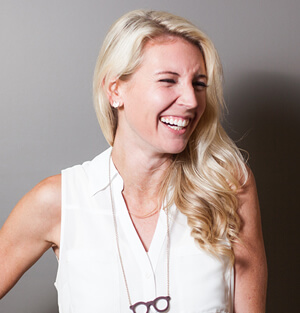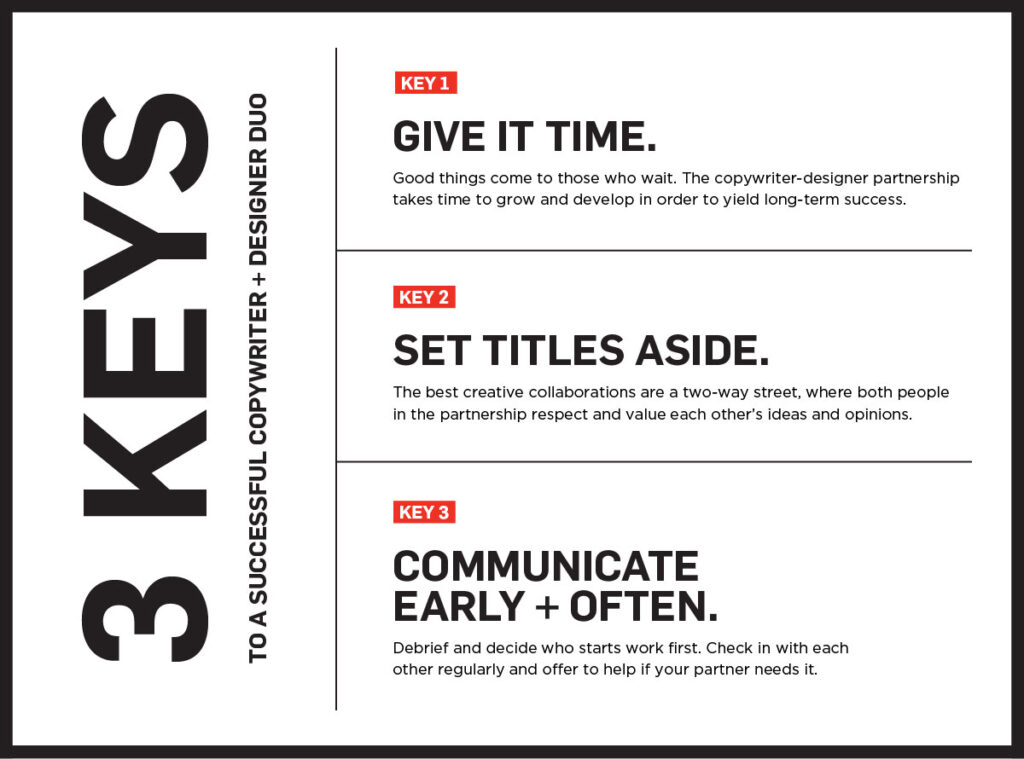
Did We Just Become Best Friends?
Lucy and Ethel.
Fred and Barney.
Rachel and Monica.
Brennan and Dale.
They don’t have to carpool to work, live in the same apartment or “go do karate in the garage” on weekends. But on the clock, there are two people who should team up to form the ultimate duo: a copywriter and a designer.
By “team up” I quite literally mean these two individuals should sit near each other and attend the same meetings. They should share ideas and build on each other’s skills. They should do equal amounts of work and present the work together. Because when all of that happens, guess what happens next? They create a final product that’s better and more effective than either could create alone.
Advertising agencies have a long history of copywriters and designers working closely together. But it’s important for these creative minds to collaborate in any industry or work environment, as a strong partnership between the two has been tested and proven to produce more successful projects. So, whether you’re familiar with or brand-new to this concept, here are three tips for keeping the relationship in check.
TIP #1: Give it time.
The most successful copy-design partnerships are never forced, nor do they happen right away. They develop naturally over time. So don’t set the bar too high when a new copywriter is first paired with a veteran designer (or vice-versa). In time, the two will become more comfortable working together, and more importantly, more comfortable disagreeing with each other. A person’s opinion of their own work will always be subjective, so it’s critical for both individuals to feel they can be honest when the work doesn’t feel like it’s quite hitting the mark.
In the same vein, a writer and a designer should be able to acknowledge each other’s strengths and weaknesses, as well as their own. For example, if a copywriter comes in with prior catalog experience, they may have helpful insight about catalog layouts. But they must also know when to defer to the designer for the overall design. Likewise, designers must recognize when to put their design elements second so that the message can shine. Design and copy hold equal weight, and both must be on-point for the final product to succeed.
Bottom line: Good things come to those who wait. The copywriter-designer partnership takes time to grow and develop in order to yield long-term success.
TIP #2: Set titles aside.
Something I realized early on when working in an agency setting is that designers can have some pretty stellar copy ideas. Sometimes what they flag as “placeholder” headlines are so good that I don’t have to change them at all (because changing something just to say you changed it is a huge waste of time).
Like designers who have an ear for good copy, copywriters can have an eye for good design. In fact, they should have ideas for how their message can be visually displayed on a page. Even if the designer doesn’t use that exact idea, it can help them approach the design in a different way or explore an option they hadn’t considered. The main thing to keep in mind, whether you’re the writer or the designer, is that you never want to come across as telling your counterpart how to do their job, just as offering ideas.
Bottom line: The best creative collaborations are a two-way street, where both people in the partnership respect and value each other’s ideas and opinions.
TIP #3: Communicate early and often.
Copy and design are often a chicken-and-egg situation. Which is why it’s important to decide which will come first before either person gets to work. An experienced duo might quickly and easily decipher the order in which they plan to attack a project, while a new copy-design pair might need guidance from an account coordinator or project manager on which part should come first.

In my experience, there is no right or wrong order. I’ve written copy before and after the design is in place. But the process for deciding which comes first is always the same: After a project kick-off meeting, the designer and I have a quick debrief. Did we hear the same things? Is the deliverable clear? Do either of us have any initial copy ideas? Design ideas?
After we get to work, we keep an open dialogue. The designer doesn’t drop a wireframe in my lap and say “see ya later.” We check in with each other to ensure we’re still on target to meet our deadline, and we let the other person know if we hit a snag. For example, a designer might ask me to cut a few lines of copy, or I might ask them for a little more headline room if I have an idea that doesn’t quite fit.
Bottom line: There is no such thing as overcommunication. Check in with each other regularly and offer to help if your partner needs it.
Remember that a copywriter and designer should work closely together, but that doesn’t mean they have to be attached at the hip all day. They can go their separate ways for their different tasks, just as long as they regroup and check in with each other as the project progresses and the deadline approaches. And, when they create cool things together, chances are they’ll create something outside of the office that’s pretty cool too: a genuine friendship.
Want to chat more about copy and design, or better yet, create something together? Reach out to info@jschmid.com.
Tags: copy and design, Copywriting, creative callaborations, Kelsey Finley, partnerships, team, teamwork
